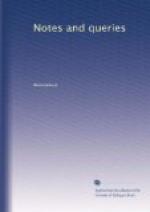The similarity which has been observed to exist between the manners of several American nations, and those of some of the oldest nations on our continent, which seems to demonstrate that this country was not unknown in ancient times, has been traced by Nicholls, in the first part of his Conference with a Theist, in several particulars, viz. burning of the victim in sacrifices, numbering by tens, fighting with bows and arrows, their arts of spinning, weaving, &c. The arguments, multitudinous as they are, adduced by Adair for his hypothesis that the American Indians are descended from the Jews, serve to prove that the known or old world furnished the new one with men. To these may be added the coincidences noticed in “NOTES AND QUERIES;” burning the dead (Vol. i., p. 308.); the art of manufacturing glass (p. 341.); scalping (Vol. ii., p. 78.). Your correspondents will doubtless be able to point out other instances. Besides drinking out of the skulls of their enemies, recorded of the Scythians by Herodotus; and of the savages of Louisiana by Bossu; I beg to mention a remarkable one furnished by Catlin—the sufferings endured by the youths among the Mandans, when admitted into the rank of warriors, {110} reminding us of the probationary exercises which the priests of Mithras forced the candidates for initiation to undergo.
T.J.
[Footnote 7: Forster, the translator of this work, annihilates the argument for the settlement of the Welsh derived from the word “penguin” signifying “white head,” by the fact of the bird in question having a black, not a white head!]
Collar of SS. (Vol. ii., p. 89.).—B. will find a great deal about these collars in some interesting papers in the Gentleman’s Magazine for 1842, vols. xvii. and xviii., conmunicated by Mr. J.G. Nicholls; and in the Second Series of the Retrospective Review, vol. i. p. 302., and vol. ii. pp. 156. 514. 518. Allow me to add a Query: Who are the persons now privileged to wear these collars? and under what circumstances, and at what dates, was such privilege reduced to its present limitation?
[Greek: Phi.]
Martello Towers (Vol. ii., p. 9.).—A misspelling for Mortella towers. They are named after a tower which commands the entrance to the harbour of St. Fiorenzo, in Corsica; but they are common along the coasts of the Mediterranean. They were built along the low parts of the Sussex and Kent coasts, in consequence of the powerful defence made by Ensign Le Tellier at the Tower of Mortella, with a garrison of 38 men only, on 8th February, 1794, against an attack by sea, made by the Fortitude and Juno, part of Lord Hood’s fleet, and by land, made by a detachment of troops under Major-General Dundas. The two ships kept up a fire for two hours and a half without making any material impression, and then hauled out of gun-shot, the Fortitude having lost 6 men killed and 56 wounded, 8 dangerously.




